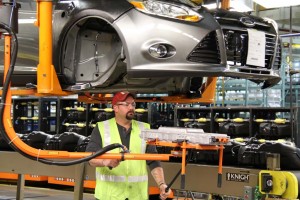Ford Motor Co.’s U.S. workers will share in the company’s strong 2012 performance, each union employee receiving, on average, an $8.300 profit-sharing bonus.
That’s the single-largest profit-sharing payout from any domestic automaker since the United Auto Workers Union introduced the program as a trade-out for concessions during 1983 contract negotiations.
The profit-sharing program is tied to Ford’s earnings in North America where it reported a pre-tax profit of $8.3 billion for 2012. The maker meanwhile reported it earned $1.7 billion before taxes during the fourth quarter, Ford’s best figure for the three-month period in more than a decade. However, net income for all of 2012 declined $307 million, excluding special charges, to $5.7 billion.
A total of 45,800 UAW hourly workers will receive bonuses, though the final figure for each employee will vary depending upon the actual number of hours they clocked on the job. But on average it will come to $8,300 before taxes.
Ford has been trying to reward and incentivize all of its stakeholders lately, the maker recently announcing it will double its quarterly dividend to 10 cents a share. Meanwhile, another 20,000 salaried employees will receive bonuses for the second year in a row, though the maker says it has not yet calculated the final figures.
Those white-collar employees were granted bonuses and merit pay increases last year for the first time since 2008. Additional merit hikes will be granted on April 1.
The formula used to determine UAW bonuses is based on earnings throughout North America, which essentially operates as a single entity, rather than on Ford’s global profitability. That effectively shielded union members from the impact of the deep recession in Europe, where Ford lost $1.73 billion – significantly more than the $1.5 billion the maker has originally forecast following the release of its third-quarter 2012 earnings.
(For more on Ford’s 2012 and Q4 earnings, Click Here.)
Ford’s profit-sharing program has become an alternative to the pay hikes that the UAW had traditionally negotiated. The maker has not granted a wage increase since the middle of the last decade and, if anything, has lowered the wage of the average UAW member through the introduction of a two-tier wage system.
But because of the tie to North American earnings, the program failed to pay out anything between 2005 and 2008. Ironically, because of concessions that have lowered Ford’s U.S. labor costs from around $75 an hour in 2007 to around $55 today, the maker’s breakeven point in North America has significantly improved, allowing for higher profit-sharing as the overall U.S. economy and the new car market, in particular, recover.
Chrysler, which is reporting a nearly nine-fold increase in its 2012 earnings is expected to also deliver a much larger profit-sharing check to UAW members.
(For more on Chrysler’s earnings, Click Here.)
General Motors has yet to report its 2012 earnings and profit sharing plans.

